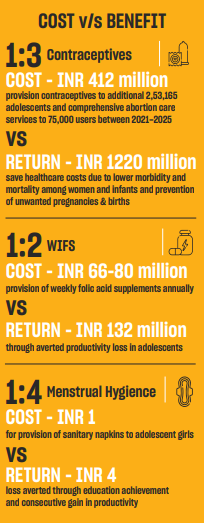Social Justice
Adolescents’ Sexual and Reproductive Health: Rajasthan
- 16 Oct 2021
- 5 min read
Why in News
Recently, findings of a study titled “Returns on Investment in Adolescents’ Sexual and Reproductive Health in Rajasthan” were released.
- Adolescents are a heterogeneous group aged between 10 and 19 years, who are in different stages of development, live in varying circumstances and have distinct needs.
Key Points
- About Study
- It examines the economic and health benefits that could accrue from increased investment in adolescents’ sexual and reproductive health-specific interventions in Rajasthan.
- The study has calculated the benefit-cost ratio to conclude that for every Rs. 100 spent on meeting the unmet needs of adolescents, there will be a return of approximately Rs. 300 in terms of healthcare costs saved.
- It also explores the potential for scaling up the services such as Access to contraceptives; Comprehensive Abortion Care (CAC); Weekly Iron and Folic acid Supplementation (WIFS); and, Menstrual Hygiene Schemes (MHS) across the state.
- It examines the economic and health benefits that could accrue from increased investment in adolescents’ sexual and reproductive health-specific interventions in Rajasthan.
- Adolescents in India
- Population: With 253 million adolescents (which implies that every fifth person in India is an adolescent), India has an unprecedented opportunity to accelerate economic development and reduce poverty.
- Challenges to Healthy Development: A variety of factors that include structural poverty, social discrimination, regressive social norms, inadequate education, and early marriage and childbearing, especially in the marginalized and under-served sections of the population .
- The Case of Rajasthan
- Adolescent Population: The total adolescent population of Rajasthan is 15 million or 23% of the total population in the state. Of these, 53% are males and 47% are females.
- Child Marriage and Adolescent Pregnancy: It continues to be of concern in Rajasthan as more than one-third of the girls (35.4%) get married before 18 years of age and 6.3% in the age group of 15-19 years are already mothers.
- This is significantly higher than the national average of 27%.
- Impact on Mother and Infant
- Birth-related Complications: Adolescent mothers aged 10-19 years face higher risks of birth-related complications like eclampsia, puerperal endometritis (uterine infection) and other systemic infections than women of higher age groups.
- Risk to Newborn: Babies born to adolescent mothers also face a higher risk of low birth weight, prematurity, birth injuries, stillbirth and infant mortality.
- Restrict Career Choices: Health problems, lack of education and the responsibilities of parenthood combine to further restrict the adolescent’s future economic opportunities and career choices.
- Suggestions
- Development of new standards and guidelines to improve the quality of reproductive health services.
- The State government should prudently invest in ensuring that the working age population is healthy and literate, and has access to resources.
- While the adolescent-specific health interventions needed to be sensitive to their requirements, nutrition supplementation programmes should also be strengthened and scaled up.
- Increase in the modern contraceptive prevalence rate for spacing methods from the existing 10.1% to 32% in the 2021-25 period.
- Adoption of a multi-faceted and innovative approach to reach out to adolescents.
Initiatives Taken
- Rajasthan
- Zero Teenage Pregnancy Campaign: The aim of the campaign is to create greater awareness around teenage pregnancy in Rajasthan and encourage stakeholders to make a strong commitment towards ending teenage pregnancy.
- National Initiatives
- Adolescent Friendly Health Services Program: Rashtriya Kishor Swasthya Karyakram is there, where female adolescents are sensitised about their health.
- Scheme for Adolescent Girls: To facilitate, educate and empower Adolescent Girls (AGs) so as to enable them to become self-reliant and aware citizens.
- Poshan Abhiyan and PM-Poshan Scheme to address the issue of malnutrition.







